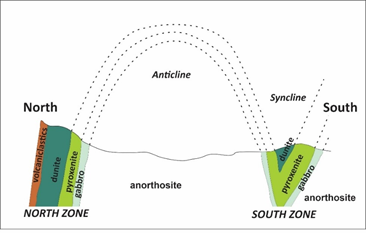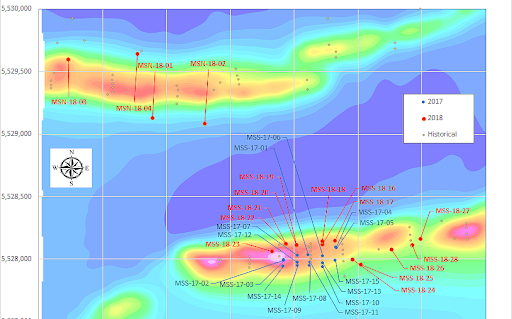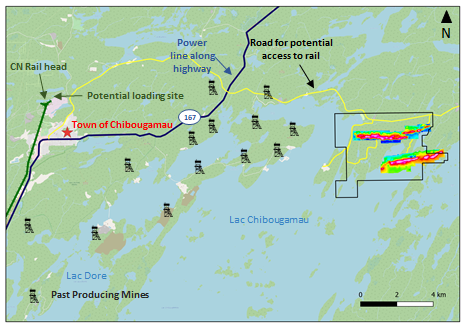Mont Sorcier Iron
The Mont Sorcier Iron ore property hosts a large high quality Iron resource with significant and extractable Vanadium in a top tier mining jurisdiction. The Mont Sorcier Iron-Vanadium deposit consists of a North and South deposit that boast exceptionally low Titanium content, allowing for simple extraction of the Vanadium metal by a blast furnace, making the deposit and possible product unique in the world markets.
Excellent Mining Jurisdiction
Located just 18 km outside of Chibougamau, Quebec by road Mont Sorcier boasts impressive existing infrastructure in one of the world’s top tier mining jurisdictions.
The Mont Sorcier property is less than 10 km from low-cost provincial Hydro along maintained roads. Roads lead directly from Mont Sorcier to the rail head less than 20 km away. The railway is underutilized by approximately 45% and provides direct access to several deep water ports in Quebec.
Located north of the 49th parallel, Mont Sorcier is eligible for support by the Quebec government through Plan Nord, a program focused on supporting mining and development in northern Quebec.
High Quality Iron Ore
Low titanium (< 2%) and deleterious elements such as phosphorus, aluminum, and silica speak to the high quality of Iron Ore and Vanadium present at Mont Sorcier as observed in the NI 43-101 resource estimate for Mont Sorcier in Table 2.
Table 2: NI 43-101 compliant resource estimate for Mont Sorcier (May 2021)*

Notes to accompany the Mineral Resource Estimate:
- The independent and qualified persons for the mineral resource estimate, as defined by NI 43-101, are Marina Iund, P.Geo., Carl Pelletier, P.Geo., Simon Boudreau, P.Eng. all from InnovExplo Inc. and Mathieu Girard P.Eng from Soutex. The effective date is June 6th, 2022.
- These mineral resources are not mineral reserves, as they do not have demonstrated economic viability. The mineral resource estimate follows current CIM definitions and guidelines.
- The results are presented undiluted and are considered to have reasonable prospects for eventual economic extraction by having constraining volumes applied to any blocks using Whittle software and by the application of cut-off grades for potential open-pit extraction method
- The estimate encompasses two (2) deposits (North and South), subdivided into 8 individual zones (7 for North, 1 for South).
- No high-grade capping was applied.
- The estimate was completed using sub-block models in GEOVIA Surpac 2021.
- Grade interpolation was performed with the ID2 method on 4 m composites for the North deposit and on 10 m composites for the South deposit.
- The density of the mineralized zones was interpolated with the ID2 method. When no density analysis was available, the density value was estimated using linear regression with Fe2O3 analysis. For the unmineralized material, a density value of 2.8 g/cm3 (anorthosite and volcanics), 3.5 g/cm3 (Massive sulfide formation) and 2.00 g/cm3 (overburden) was assigned.
- The mineral resource estimate is classified as Indicated and Inferred. The Inferred category is defined with a minimum of two (2) drill holes for areas where the drill spacing is less than 400 m, and reasonable geological and grade continuity have been shown. The Indicated category is defined with a minimum of three (3) drill holes within the areas where the drill spacing is less than 200 m, and reasonable geological and grade continuity have been shown. Clipping boundaries were used for classification based on those criteria.
- The mineral resource estimate is locally pit-constrained for potential open-pit extraction method with a bedrock slope angle of 50° and an overburden slope angle of 30°. It is reported at a rounded cut-off grade of 2.30 % Weighted recovered Fe (Fe % x Process Recovery). The cut-off grade was calculated for the concentrate using the following parameters: royalty = 3%; mining cost = CA$3.30; mining overburden cost = CA$2.45; processing cost = CA$3.62; G&A = CA$0.75; selling costs = CA$58.36; Fe price = CA$190/t; USD:CAD exchange rate = 1.3; and mill recovery = 100% (concentrate). The cut-off grades should be re-evaluated considering future prevailing market conditions (metal prices, exchange rates, mining costs etc.).
- The number of metric tonnes was rounded to the nearest thousand, following the recommendations in NI 43-101 and any discrepancies in the totals are due to rounding effects.
- The authors are not aware of any known environmental, permitting, legal, title-related, taxation, socio-political, or marketing issues, or any other relevant issue not reported in the Technical Report, that could materially affect the Mineral Resource Estimate.
Note that the Inferred in the current table are slightly different from those disclosed on June 9, 2022. In the course of writing this technical report, some adjustments were made to some deep inferred blocks in the block model resulting in a small decrease of the inferred MRE. The total has gone from 595 Mt to 547 Mt total inferred. The lost tonnage of Inferred is transferred to exploration potential.
A Unique Opportunity
Exceptionally low titanium content at Mont Sorcier makes the deposits unique to other Fe-Ti-V deposits in Quebec and around the world. Low Titanium (TiO2) in the deposit allows the Iron ore and Vanadium (V2O5) processing directly through a blast furnace.
The layered mafic-ultramafic rocks that form the Mont Sorcier North and South zones are the same stratigraphic unit that have undergone km-scale folding. The North zone represents the north-dipping limb of the anticlinal fold structure and the South zone represents the hinge zone of a syncline (see Figure 4).

Figure 4: Structural relationship between the North and South zone (after Dorr, 1969).
Historical Data
Drilling completed by Campbell Mines at Mont Sorcier in the 1960s was used to assess the Iron and later the Iron-Vanadium potential of the property. In addition to drilling and assaying Campbell Mines performed detailed metallurgical work, produced mineral reserve estimates (non-compliant), and a detailed feasibility study.
Voyager Metals continues to use results from Campbell Mines to efficiently and ethically advance National Instrument-compliant mineral resource estimation and economic feasibility of Mont Sorcier.
Work by Voyager Metals
Voyager Metals has been engaged in exploration activities to recognize the mineral resource and economic potential of the Mont Sorcier property. These activities include drilling, field geology, verification of historic data, metallurgy work, and commencing an economic assessment of the property.
In 2017 and 2018 Vanadium One Iron drilled over 7,000m in 32 holes in the North and South zone. Results from the Fall 2018 drill campaigns at Mont Sorcier demonstrate large intercepts of high quality iron ore with good Vanadium content (Table 3; Figure 5).
Additional work performed by the Company can be found in our Press Releases.
Table 3: Results from 2018 Drill campaign
| Head Grades | DTT (Concentrate) | ||||||||
| Area | Hole | From | To | Length | Fe2O3 | V2O5 | Fe | V2O5 | TiO2 |
| m | m | m | % | % | % | % | % | ||
| North Zone | MSN-18-01 | 270 | 552 | 282 | 32.6 | 0.17 | 55 | 0.43 | 2.37 |
| MSN-18-02 | 270 | 524 | 254 | 39 | 0.33 | 61 | 0.63 | 2.16 | |
| MSN-18-03 | 167 | 283 | 116 | 39.9 | 0.26 | 60 | 0.57 | 1.37 | |
| MSN-18-04 | 215 | 380 | 165 | 39.4 | 0.22 | 59 | 0.48 | 1.66 | |
| South Zone | MSS-18-16 | 21 | 148 | 127.4 | 39.6 | 0.3 | 66 | 0.6 | 1.07 |
| (Centre) | MSS-18-17 | 12 | 105 | 92.6 | 38.4 | 0.31 | 65 | 0.62 | 2.04 |
| MSS-18-18 | 27 | 270 | 243 | 34.8 | 0.5 | 65 | 0.5 | 1.29 | |
| MSS-18-19 | 35 | 221 | 186.2 | 38.9 | 0.28 | 64 | 0.55 | 1.1 | |
| MSS-18-20 | 58 | 192 | 134 | 45.9 | 0.4 | 65 | 0.71 | 1.02 | |
| MSS-18-21 | 56 | 201 | 145 | 34.7 | 0.24 | 61 | 0.53 | 1.39 | |
| MSS-18-22 | 113 | 210 | 97.4 | 38 | 0.29 | 65 | 0.63 | 1.21 | |
| MSS-18-23 | 3 | 52.4 | 49.4 | 40.8 | 0.28 | 62 | 0.53 | 0.94 | |
| MSS-18-24 | 84.6 | 198 | 113.5 | 34.2 | 0.21 | 66 | 0.46 | 1.55 | |
| South Zone | MSS-18-25 | 122 | 151 | 28.6 | 39 | 0.2 | 66 | 0.41 | 1.48 |
| (East) | MSS-18-26 | 68.8 | 132 | 63.2 | 23.6 | 0.14 | 44 | 0.36 | 2.07 |
| MSS-18-27 | 66.5 | 92 | 25.5 | 32.6 | 0.22 | 58 | 0.4 | 1.98 | |
| MSS-18-28 | 123 | 155 | 32.2 | 28.8 | 0.19 | 62 | 0.43 | 1.74 | |

Sources
Dorr, A. (1969). Magnetite Deposits in the Northern Part of the Doré Lake Complex, Chibougamau District, Québec. Master’s thesis, McGill University, Montréal, QC, Canada.
Mathieu, L. (2019). Origin of the Vanadiferous Serpentine–Magnetite Rocks of the Mt. Sorcerer Area, Lac Doré Layered Intrusion, Chibougamau, Québec. Geosciences, 9(3), 110.

Sign up for our newsletter





